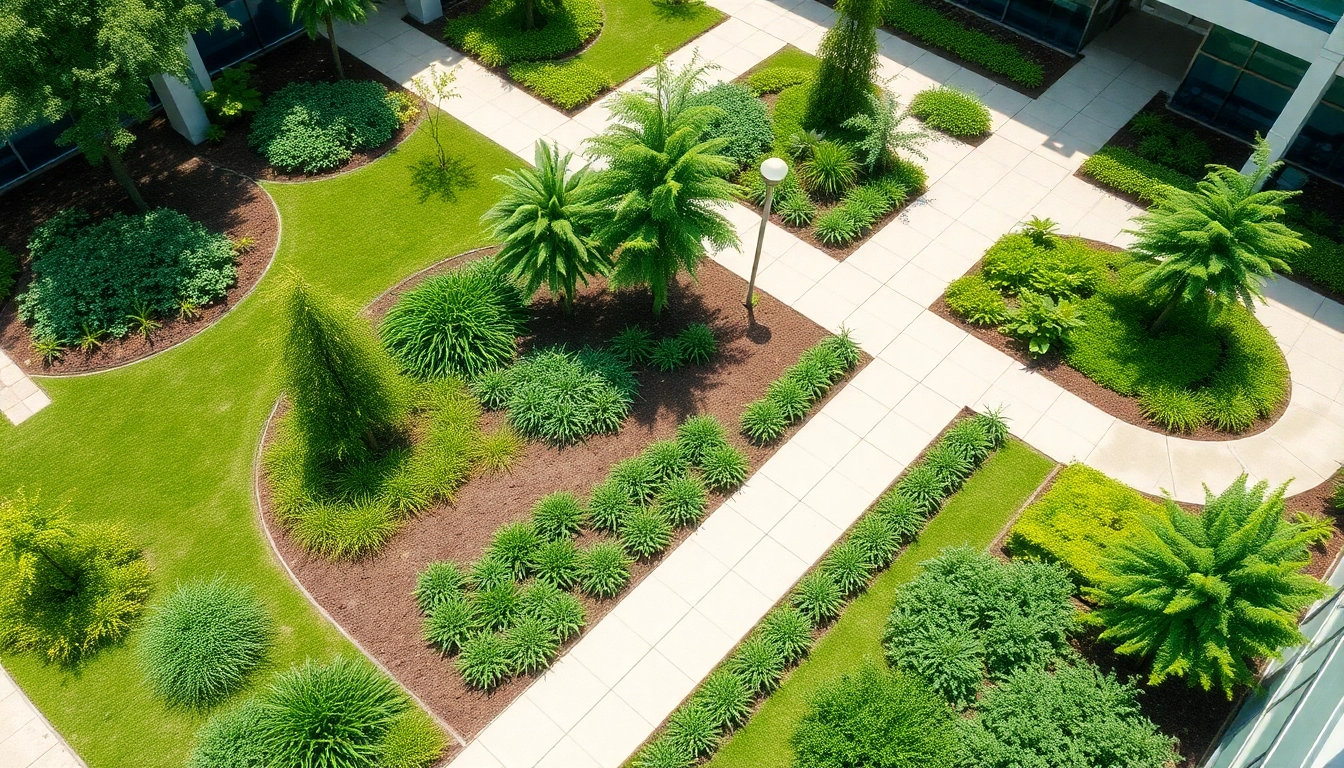Understanding the Role of Commercial Landscaping Contractors
In the bustling landscape of commercial real estate, the aesthetic appeal of a property can have a profound impact on its success. This is where commercial landscaping contractors come into play, serving as pivotal players in shaping outdoor spaces that not only attract tenants but also enhance property value. As businesses seek to create inviting environments, the role of these specialized contractors becomes increasingly crucial.
What Is Commercial Landscaping?
Commercial landscaping refers to the design, installation, and maintenance of green spaces on commercial properties, which can include office buildings, retail centers, parks, and industrial complexes. Unlike residential landscaping, commercial landscaping is tailored to meet the specific needs of businesses while considering functionality, safety, and aesthetics. Key elements usually encompass plant selection, irrigation systems, hardscaping, and ongoing maintenance services.
Importance of Professional Contractors in Commercial Spaces
Hiring professional landscaping contractors is not merely about aesthetics; it directly influences the strategic goals of a business. A well-maintained landscape can positively affect customer perception, reduce energy costs through strategic planting, and create functional outdoor spaces for employees and patrons alike. Furthermore, commercial contractors possess the expertise to navigate zoning laws, environmental regulations, and design standards that can be complex for untrained individuals.
Common Services Offered by Commercial Landscaping Contractors
Commercial landscaping contractors typically offer a wide array of services, including but not limited to:
- Landscape Design: Creating visually appealing and functional outdoor spaces tailored to a business’s image.
- Irrigation Management: Installing and maintaining irrigation systems to ensure efficient water usage.
- Lawn Care and Maintenance: Regular mowing, fertilization, and pest control to keep lawns healthy.
- Seasonal Clean-up: Preparing landscapes for changing seasons, which can include leaf removal in autumn and snow removal in winter.
- Hardscaping: Installation of pathways, patios, and retaining walls to enhance the usability of outdoor areas.
- Tree and Shrub Care: Trimming, pruning, and planting to maintain health and aesthetics.
Choosing the Right Contractor for Your Needs
With a plethora of options available, selecting the right commercial landscaping contractor can be daunting. It is essential to identify a contractor that aligns with your project requirements, budget, and company values.
Key Qualities to Look For in Commercial Landscaping Contractors
When evaluating potential contractors, consider the following qualities:
- Experience and Expertise: Look for contractors with a proven track record in commercial landscaping and a strong portfolio that showcases their previous work.
- Licensing and Insurance: Ensure the contractor is licensed and insured to protect against any liability arising from accidents or damages during the project.
- Reputation: Research online reviews and ask for references to gauge client satisfaction and contractor reliability.
- Communication Skills: Choose a contractor who communicates clearly and is open to collaboration, ensuring your vision is understood and met.
- Innovation and Sustainability: A forward-thinking contractor will embrace eco-friendly practices and modern design trends, enhancing the commercial landscape’s sustainability.
Questions to Ask Before Hiring
Prior to making a hiring decision, it is vital to ask prospective contractors key questions that reveal important details about their services and approach:
- What is your project timeline, and how do you handle delays?
- Can you provide references from past commercial clients?
- What is included in your estimate, and how do you approach budgeting?
- Do you offer maintenance plans after the project completion?
- How do you ensure adherence to local regulations and codes?
Reviewing Portfolios and Client Testimonials
It’s essential to thoroughly review a contractor’s portfolio to understand their design style and capabilities. Pay attention to:
- The diversity of projects they’ve handled—this gives insight into their versatility.
- The quality of maintenance demonstrated—healthy, thriving landscapes indicate their dedication to ongoing care.
- Client testimonials that speak to their professionalism, reliability, and results.
Cost Factors of Commercial Landscaping Services
Understanding the cost dynamics of commercial landscaping can help businesses budget more effectively, ensuring that they make informed decisions that align with their financial resources.
Understanding Pricing Models for Commercial Landscaping
Commercial landscaping costs can vary widely based on several factors, including project size, complexity, and location. Typically, landscaping services may be charged by the hour, square footage, or as a fixed project fee. Here are some common pricing models:
- Per Square Foot: Ideal for larger projects where price can be calculated based on the area being landscaped.
- Hourly Rate: Suitable for projects that require ongoing or smaller-scale maintenance.
- Flat Rate: For well-defined projects where scope and requirements are clear, providing certainty about total costs.
What Affects the Cost of Landscaping Projects?
Several factors influence the overall cost of commercial landscaping projects, including:
- Design Complexity: Intricate designs that require specialized labor and materials will be more expensive.
- Material Quality: Using high-quality plants, materials, and hardscaping elements can raise costs but lead to longer-lasting results.
- Geographic Location: Costs may fluctuate depending on the local cost of labor and materials.
- Seasonality: Availability of materials and labor can affect pricing, with peak seasons potentially increasing costs.
Budgeting for Commercial Landscaping Services
Proper budgeting is essential for ensuring that landscaping projects can be completed without unexpected financial strain. Consider these tips:
- Get multiple quotes from contractors to compare pricing structures.
- Include additional costs such as permits, soil preparation, and ongoing maintenance in your budget.
- Factor in contingency funds—typically 10-20% of the total budget—to cover unforeseen expenses.
Best Practices in Commercial Landscaping Maintenance
Maintaining a commercial landscape is just as critical as the initial design and installation. Continuing care ensures the longevity of the plantings and ongoing beauty of the space.
Scheduling Regular Maintenance for Optimal Results
Regular maintenance is essential for ensuring that landscapes not only look good but also thrive. Create a maintenance schedule that includes:
- Routine lawn care, including mowing and fertilization.
- Seasonal cleanups to remove debris and prepare for seasonal changes.
- Periodic inspections to identify any potential issues such as pests or diseases early in their development.
Eco-Friendly Approaches to Landscaping
Adopting environmentally friendly practices in commercial landscaping not only contributes positively to the planet but can also enhance a business’s reputation. Some methods include:
- Native Plant Selection: Using local plants that require less water and care.
- Rainwater Harvesting: Implementing systems to capture and utilize rainwater for irrigation.
- Organic Maintenance: Utilizing non-chemical fertilizers and pest control to promote a healthier ecosystem.
Utilizing Technology in Landscape Maintenance
Incorporating technology in landscape maintenance can streamline processes and improve outcomes. Innovative tools may include:
- Automated Irrigation Systems: Smart systems that adjust water usage based on moisture levels in the soil.
- Drone Technology: Drones for aerial inspections of large properties to identify problem areas.
- Landscape Management Software: Tools developed to assist in planning, tracking, and budgeting landscape services efficiently.
Trends in Commercial Landscaping Design
The commercial landscaping industry is always evolving, influenced by trends in architecture, environmental concerns, and shifting consumer preferences. Staying updated on these trends can offer competitive advantages.
Current Trends Shaping Commercial Landscapes
Some trends currently shaping commercial landscapes include:
- Minimalistic Designs: Clean lines and uncluttered spaces that promote tranquility.
- Outdoor Workspaces: More businesses incorporate functional outdoor spaces for employees, promoting productivity and well-being.
- Vertical Gardens: The trend towards urbanization has led to the popularity of vertical gardens that maximize limited space while adding green aesthetics.
Incorporating Sustainability into Design
Sustainability remains a driving force in landscape design, with emphasis on:
- Water-Smart Landscaping: Designing landscapes that require minimal irrigation through strategic plant selection and layout.
- Use of Permeable Materials: Hardscaping with permeable materials to prevent runoff and promote groundwater replenishment.
- Wildlife Habitats: Creating spaces that attract and support local wildlife, enhancing biodiversity.
Future-Proofing Your Commercial Landscape
To ensure long-term viability, businesses should consider future-proofing their landscapes by:
- Designing with adaptability in mind, allowing for easy modifications as business needs evolve.
- Implementing high-quality materials that withstand changing weather conditions.
- Staying informed on emerging landscaping trends and technologies that can enhance property appeal and function.



